10.2 Hunger
Anyone who has tried to restrict their eating knows that physiological influences are powerful. Their strength was vividly demonstrated when Ancel Keys and his research team (1950) studied semistarvation among wartime conscientious objectors. After three months of normal eating, they cut in half the food intake of 36 men selected from 200 volunteers. The semistarved men became listless and apathetic as their bodies conserved energy. Eventually, their body weights stabilized at about 25 percent below their starting weights.

Consistent with Abraham Maslow’s idea of a needs hierarchy, the men became food obsessed. They talked food. They daydreamed food. They collected recipes, read cookbooks, and feasted their eyes on delectable forbidden food. Preoccupied with their unmet basic need, they lost interest in sex and social activities. As one man reported, “If we see a show, the most interesting part of it is contained in scenes where people are eating. I couldn’t laugh at the funniest picture in the world, and love scenes are completely dull.”
“Nobody wants to kiss when they are hungry.”
Journalist Dorothy Dix (1861–
The semistarved men’s preoccupations illustrate how powerful motives can hijack our consciousness. When we’re hungry, thirsty, fatigued, or sexually aroused, little else seems to matter. When we’re not, food, water, sleep, or sex just don’t seem like such big things in life, now or ever.
“Nature often equips life’s essentials—
Frans de Waal, “Morals Without God?” 2010
In studies, people in a motivational “hot” state (from fatigue, hunger, or sexual arousal) have easily recalled such feelings in their own past and have perceived them as driving forces in others’ behavior (Nordgren et al., 2006, 2007). (You may recall from Chapter 8 a parallel effect of our current good or bad mood on our memories.) People in another experiment were given $4 cash they could keep or draw from to bid for foods. Hungry people overbid for a snack they would eat later when sated, and sated people underbid for a snack they would eat later when hungry (Fisher & Rangel, 2014). Grocery shop with an empty stomach and you are more likely to see those jelly-
“The full person does not understand the needs of the hungry.”
Irish proverb
The Physiology of Hunger
10-
Deprived of a normal food supply, Keys’ semistarved volunteers were clearly hungry. But what precisely triggers hunger? Is it the pangs of an empty stomach? So it seemed to A. L. Washburn. Working with Walter Cannon (Cannon & Washburn, 1912), Washburn agreed to swallow a balloon attached to a recording device (FIGURE 10.4). When inflated to fill his stomach, the balloon transmitted his stomach contractions. Washburn supplied information about his feelings of hunger by pressing a key each time he felt a hunger pang. The discovery: Washburn was indeed having stomach contractions whenever he felt hungry.

Can hunger exist without stomach pangs? To answer that question, researchers removed some rats’ stomachs and created a direct path to their small intestines (Tsang, 1938). Did the rats continue to eat? Indeed they did. Some hunger similarly persists in humans whose ulcerated or cancerous stomachs have been removed. So the pangs of an empty stomach are not the only source of hunger. What else might trigger hunger?
Body Chemistry and the Brain
glucose the form of sugar that circulates in the blood and provides the major source of energy for body tissues. When its level is low, we feel hunger.
Somehow, somewhere, your body is keeping tabs on the energy it takes in and the energy it uses. If this weren’t true, you would be unable to maintain a stable body weight. A major source of energy in your body is the blood sugar glucose. If your blood glucose level drops, you won’t consciously feel the lower blood sugar, but your stomach, intestines, and liver will signal your brain to motivate eating. Your brain, which is automatically monitoring your blood chemistry and your body’s internal state, will then trigger hunger.
How does the brain integrate these messages and sound the alarm? The work is done by several neural areas, some housed deep in the brain within the hypothalamus, a neural traffic intersection (FIGURE 10.5). For example, one neural arc (called the arcuate nucleus) has a center that secretes appetite-

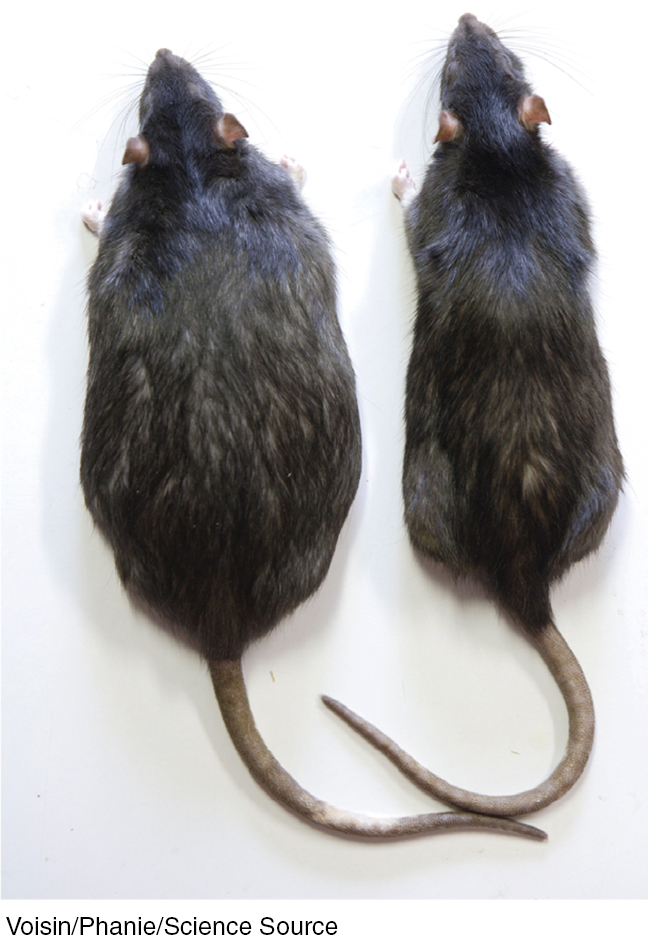
Blood vessels connect the hypothalamus to the rest of the body, so it can respond to our current blood chemistry and other incoming information. One of its tasks is monitoring levels of appetite hormones, such as ghrelin, a hunger-
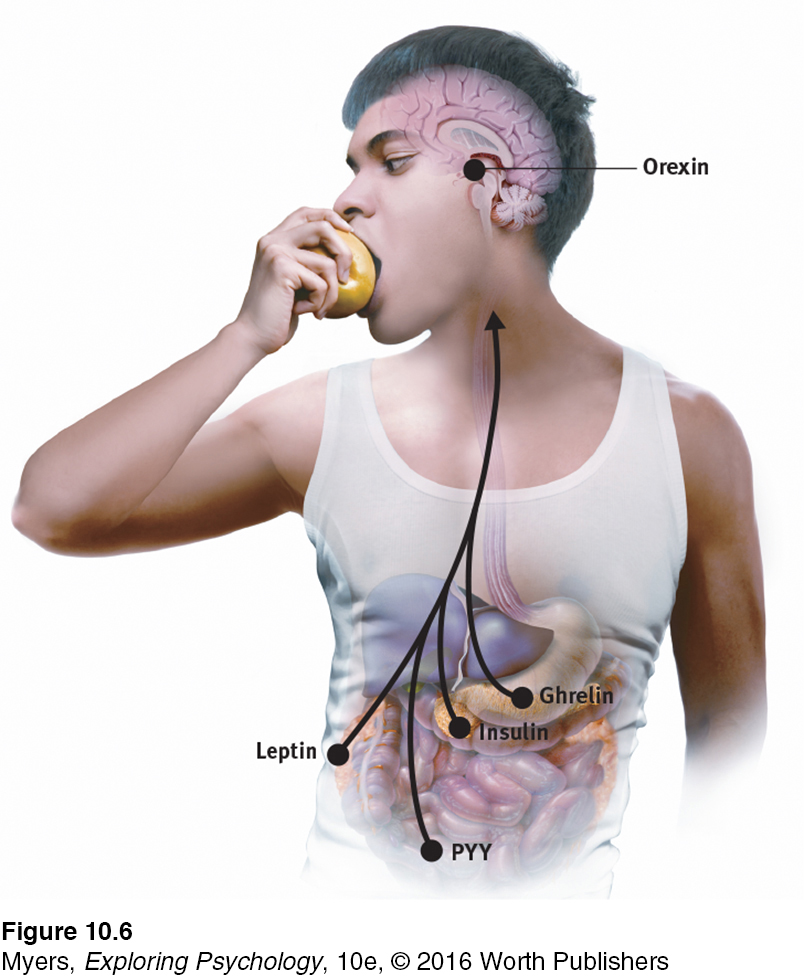
• Ghrelin: Hormone secreted by empty stomach; sends “I’m hungry” signals to the brain.
• Insulin: Hormone secreted by pancreas; controls blood glucose.
• Leptin: Protein hormone secreted by fat cells; when abundant, causes brain to increase metabolism and decrease hunger.
• Orexin: Hunger-
• PYY: Digestive tract hormone; sends “I’m not hungry” signals to the brain.
set point the point at which your “weight thermostat” is supposedly set. When your body falls below this weight, increased hunger and a lowered metabolic rate may combine to restore the lost weight.
The interaction of appetite hormones and brain activity suggests that the body has some sort of “weight thermostat.” When semistarved rats fall below their normal weight, this system signals the body to restore the lost weight. Fat cells cry out (so to speak) “Feed me!” and grab glucose from the bloodstream (Ludwig & Friedman, 2014). Hunger increases and energy output decreases. In this way, rats (and humans) tend to hover around a stable weight, or set point, influenced in part by heredity (Keesey & Corbett, 1983).
 For an interactive and visual tutorial on the brain and eating, visit LaunchPad’s PsychSim 6: Hunger and the Fat Rat.
For an interactive and visual tutorial on the brain and eating, visit LaunchPad’s PsychSim 6: Hunger and the Fat Rat.
basal metabolic rate the body’s resting rate of energy expenditure.
We humans (and other species, too) vary in our basal metabolic rate, a measure of how much energy we use to maintain basic body functions when our body is at rest. But we share a common response to decreased food intake: Our basal metabolic rate drops, as it did for participants in Keys’ experiment. After 24 weeks of semistarvation, they stabilized at three-

Some researchers have suggested that the idea of a biologically fixed set point is too rigid to explain some things. One thing it doesn’t address is that slow, sustained changes in body weight can alter a person’s set point (Assanand et al., 1998). Another is that when we have unlimited access to a wide variety of tasty foods, we tend to overeat and gain weight (Raynor & Epstein, 2001). And set points don’t explain why psychological factors influence hunger. For all these reasons, some prefer the looser term settling point to indicate the level at which a person’s weight settles in response to caloric intake and energy use. As we will see next, these factors are influenced by environment as well as biology.
RETRIEVE IT
Question
Hunger occurs in response to (low/high) blood glucose and (low/high) levels of ghrelin.
The Psychology of Hunger
10-
Our internal hunger games are pushed by our body chemistry and brain activity. Yet there is more to hunger than meets the stomach. This was strikingly apparent when trickster researchers tested two patients who had no memory for events occurring more than a minute ago (Rozin et al., 1998). If offered a second lunch 20 minutes after eating a normal lunch, both patients readily consumed it … and usually a third meal offered 20 minutes after they finished the second. This suggests that one part of our decision to eat is our memory of the time of our last meal. As time passes, we think about eating again, and those thoughts trigger feelings of hunger.
Taste Preferences: Biology and Culture
Body cues and environmental factors together influence not only the when of hunger, but also the what—our taste preferences. When feeling tense or depressed, do you tend to take solace in high-
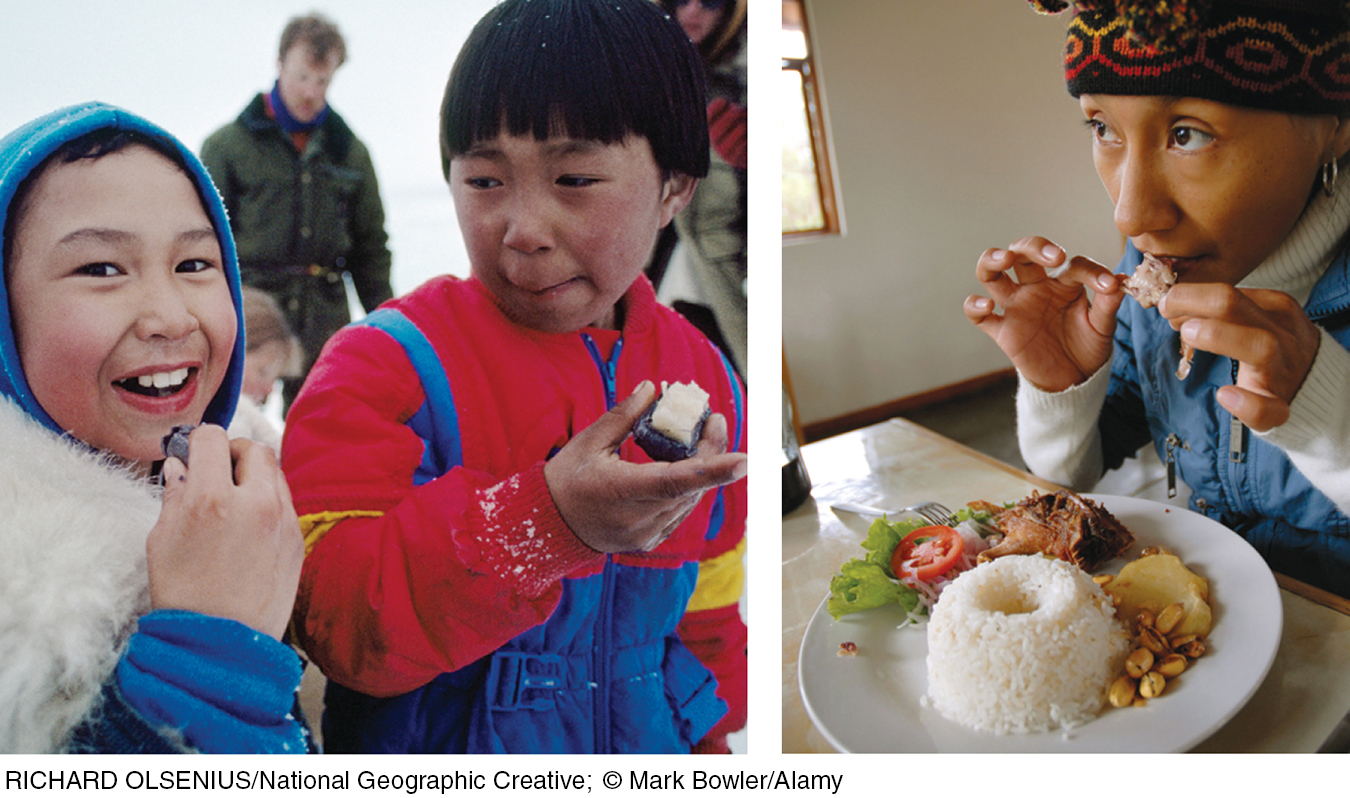
Our preferences for sweet and salty tastes are genetic and universal, but conditioning can intensify or alter those preferences. People given highly salted foods may develop a liking for excess salt (Beauchamp, 1987). People sickened by a food may develop an aversion to it. (The frequency of children’s illnesses provides many chances for them to learn to avoid certain foods.)
Our culture teaches us that some foods are acceptable but others are not. Many Japanese people enjoy nattó, a fermented soybean dish that “smells like the marriage of ammonia and a tire fire,” reports smell expert Rachel Herz (2012). Although many Westerners find this disgusting, Asians, she adds, are often repulsed by what Westerners love—
But there is biological wisdom to many of our taste preferences. For example, in hot climates (where foods spoil more quickly) recipes often include spices that inhibit bacteria growth (FIGURE 10.7). Pregnancy-
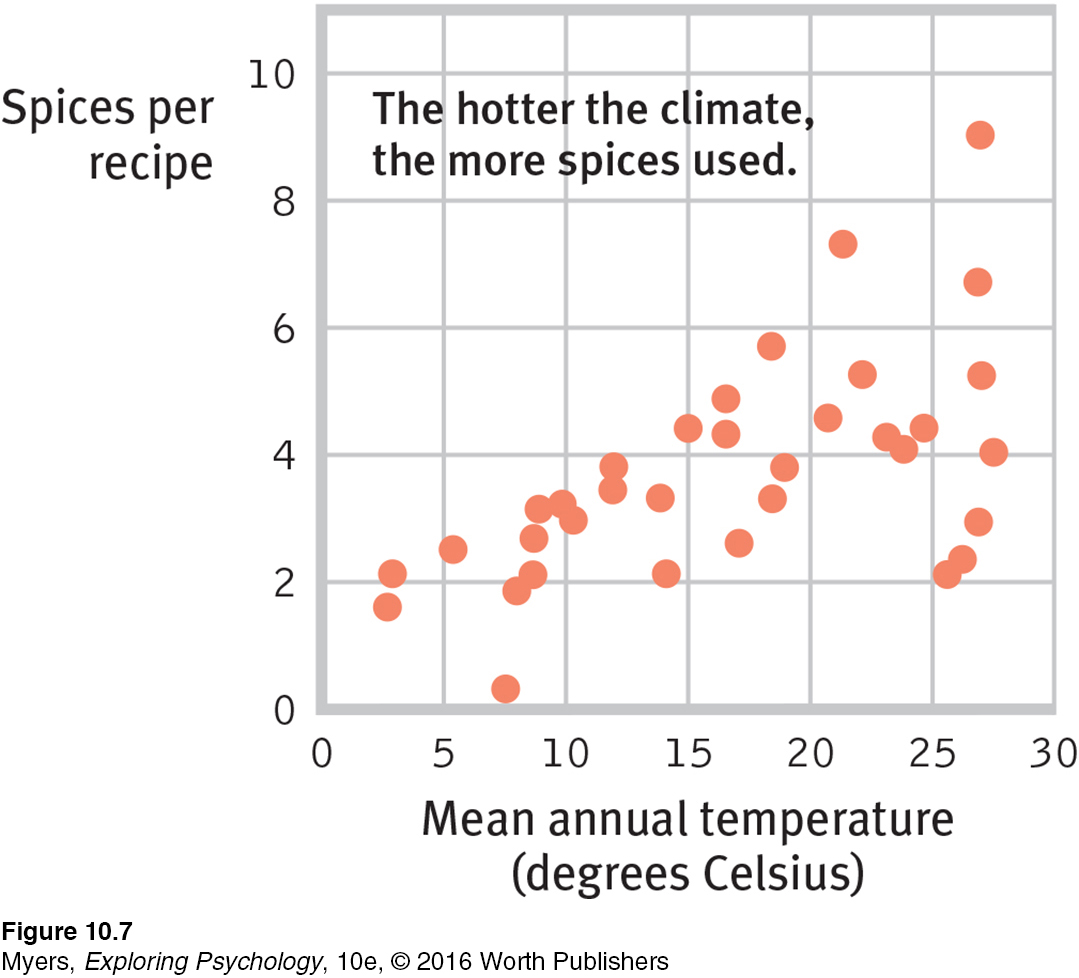
Rats tend to avoid unfamiliar foods (Sclafani, 1995). So do we, especially those that are animal-
Situational Influences on Eating
To a surprising extent, situations also control our eating—
Arousing appetite In one experiment, watching an intense action movie (rather than a nonarousing interview) doubled snacking (Tal et al., 2014).
Friends and food Do you eat more when eating with others? Most of us do (Herman et al., 2003; Hetherington et al., 2006). After a party, you may realize you’ve overeaten. This happens because the presence of others tends to amplify our natural behavior tendencies. (More about this social facilitation in Chapter 12.)
Serving size is significant “Unit bias” occurs with similar mindlessness. Investigators studied the effects of portion size by offering people varieties of free snacks. In an apartment lobby, they laid out full or half pretzels, big or little Tootsie Rolls, or a small or large serving scoop with a bowl of M&M’s. Their consistent result: Offered a supersized portion, people put away more calories. In another study, people ate more pasta when given a bigger plate (Van Ittersum & Wansink, 2012). Children also eat more when using adult-
sized (rather than child- sized) dishware (DiSantis et al., 2013). Even nutrition experts helped themselves to 31 percent more ice cream when given a big bowl rather than a small one (Wansink, 2006, 2014). Portion size matters. Page 382Selections stimulate Food variety also stimulates eating. Offered a dessert buffet, we eat more than we do when choosing a portion from one favorite dessert. For our early ancestors, variety was healthy. When foods were abundant and varied, eating more provided a wide range of vitamins and minerals and produced protective fat for winter cold or famine. When a bounty of varied foods was unavailable, eating less extended the food supply until winter or famine ended (Polivy et al., 2008; Remick et al., 2009).
Nudging nutrition One research team quadrupled carrots taken by offering schoolchildren carrots before they picked up other foods in a lunch line (Redden et al., 2015). A planned new school lunch tray will put fruits and veggies up front, and spread the entrée out in a shallow compartment to make it look bigger (Wansink, 2014).
 IMMERSIVE LEARNING Consider how researchers test some of these ideas with LaunchPad’s How Would You Know If Using Larger Dinner Plates Makes People Gain Weight?
IMMERSIVE LEARNING Consider how researchers test some of these ideas with LaunchPad’s How Would You Know If Using Larger Dinner Plates Makes People Gain Weight?
RETRIEVE IT
Question
After an eight-
Obesity and Weight Control
10-
Obesity can be socially toxic, by affecting both how you are treated and how you feel about yourself. Obesity has been associated with lower psychological well-
The Physiology of Obesity
Our bodies store fat for good reason. Fat is an ideal form of stored energy—
In parts of the world where food and sweets are now abundantly available, the rule that once served our hungry distant ancestors—
between 1980 and 2013, the proportion of overweight adults increased from 29 to 37 percent among the world’s men, and from 30 to 38 percent among women.
Page 383over the last 33 years, no country has reduced its obesity rate. Not one.
national variations are huge, with the percentage overweight ranging from 85 percent in Tonga to 3 percent in Timor-
Leste.
See www.tinyurl.com/
According to the World Health Organization (WHO), an overweight person has a body mass index (BMI) of 25 or more; someone obese has a BMI of 30 or more. In the United States, the adult obesity rate has more than doubled in the last 40 years, reaching 36 percent, and child-
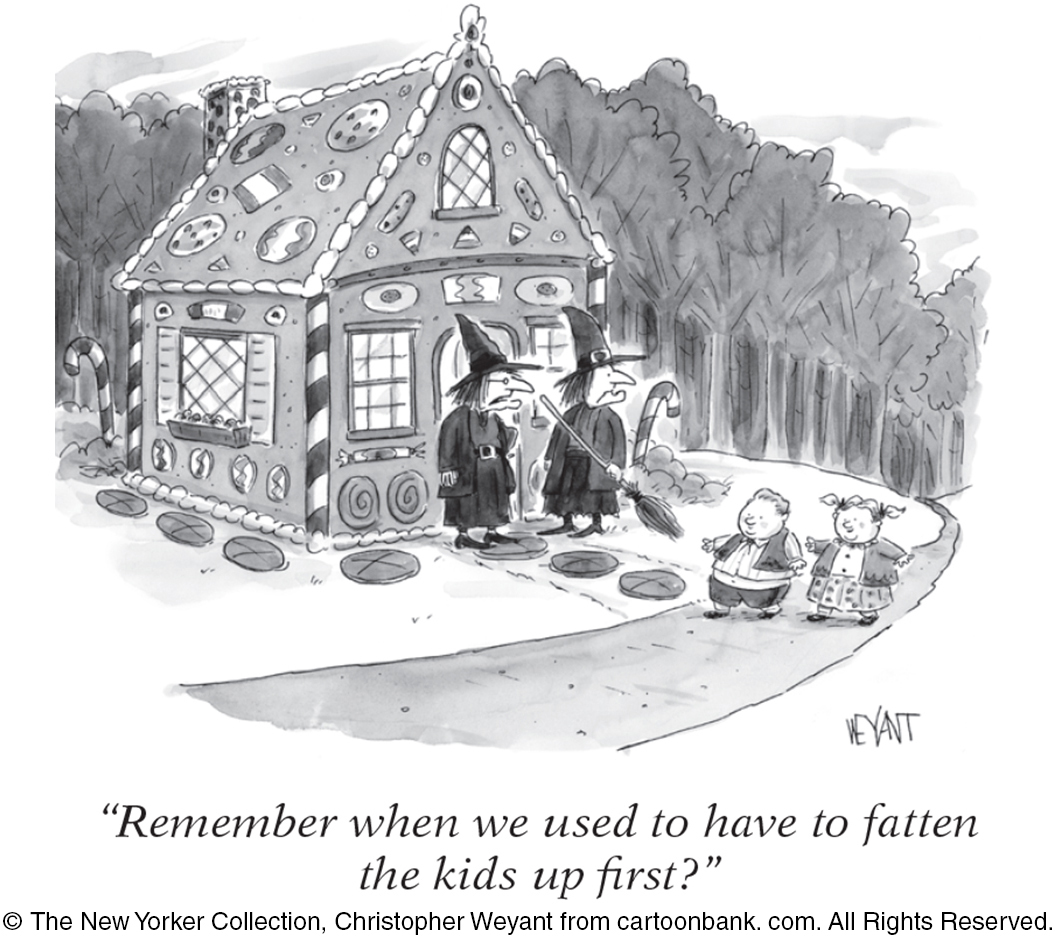
In one digest of 97 studies of 2.9 million people, being simply overweight was not a health risk, while being obese was (Flegal et al., 2013). Fitness matters more than being a little overweight. But significant obesity increases the risk of diabetes, high blood pressure, heart disease, gallstones, arthritis, and certain types of cancer, thus increasing health care costs and shortening life expectancy (de Gonzales et al., 2010; Jarrett et al., 2010; Sun et al., 2009). Research also has linked women’s obesity to their risk of late-
SET POINT AND METABOLISM Research on the physiology of obesity challenges the stereotype of severely overweight people being weak-
“American men, on average, say they weigh 196 pounds and women say they weigh 160 pounds. Both figures are nearly 20 pounds heavier than in 1990.”
Elizabeth Mendes, www.gallup.com, 2011
Lean people also seem naturally disposed to move about. They burn more calories than do energy-
THE GENETIC FACTOR Do our genes predispose us to eat more or less? To burn more calories by fidgeting or fewer by sitting still? Studies confirm a genetic influence on body weight. Consider two examples:
Despite shared family meals, adoptive siblings’ body weights are uncorrelated with one another or with those of their adoptive parents. Rather, people’s weights resemble those of their biological parents (Grilo & Pogue-
Geile, 1991). Identical twins have closely similar weights, even when raised apart (Hjelmborg et al., 2008; Plomin et al., 1997). Across studies, their weight correlates +.74. The much lower +.32 correlation among fraternal twins suggests that genes explain two-
thirds of our varying body mass (Maes et al., 1997).
 See LaunchPad’s Videos: Twin Studies and Correlational Studies, below, for helpful tutorial animations.
See LaunchPad’s Videos: Twin Studies and Correlational Studies, below, for helpful tutorial animations.
As with other behavior traits (such as intelligence, sexual orientation, and personality) there is no one “weight gene.” Rather, many genes—
THE FOOD AND ACTIVITY FACTORS Genes tell an important part of the obesity story. But environmental factors are mighty important, too.
Studies in Europe, Japan, and the United States show that children and adults who suffer from sleep loss are more vulnerable to obesity (Keith et al., 2006; Nedeltcheva et al., 2010; Taheri, 2004a, b). With sleep deprivation, the levels of leptin (which reports body fat to the brain) fall, and ghrelin (the appetite-
Social influence is another factor. One 32-
The strongest evidence that environment influences weight comes from our fattening world (FIGURE 10.8). What explains this growing problem? Changing food consumption and decreased work-

The “bottom” line: New stadiums, theaters, and subway cars—
“We put fast food on every corner, we put junk food in our schools, we got rid of [physical education classes], we put candy and soda at the checkout stand of every retail outlet you can think of. The results are in. It worked.”
Harold Goldstein, Executive Director of the California Center for Public Health Advocacy, 2009, when imagining a vast U.S. national experiment to encourage weight gain
Note how these findings reinforce a familiar lesson from Chapter 9’s discussion of intelligence: There can be high levels of heritability (genetic influence on individual differences) without heredity explaining group differences. Genes mostly determine why one person today is heavier than another. Environment mostly determines why people today are heavier than their counterparts 50 years ago. Our eating behavior also demonstrates the now-
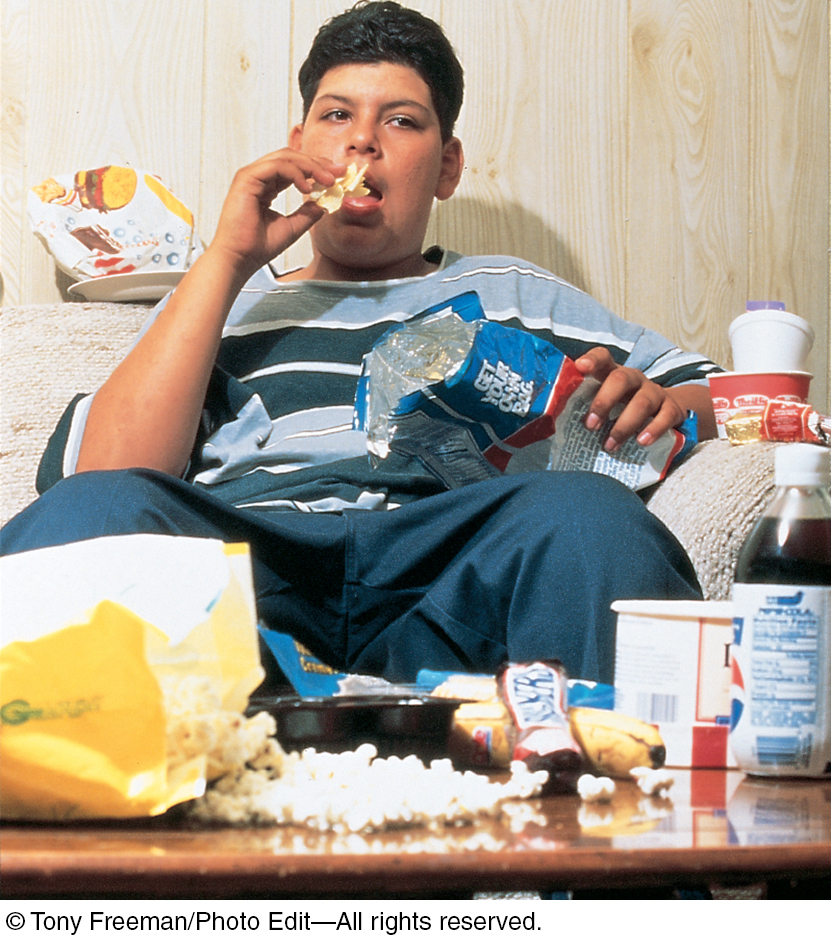
Waist Management
| People struggling with obesity are well advised to seek medical evaluation and guidance. For others who wish to lose weight, researchers have offered these tips: |
|
RETRIEVE IT
Question
Why can two people of the same height, age, and activity level maintain the same weight, even if one of them eats much less than the other does?
REVIEW Hunger
Learning Objectives
Test Yourself by taking a moment to answer each of these Learning Objective Questions (repeated here from within the chapter). Research suggests that trying to answer these questions on your own will improve your long-
Question
10-
Question
10-
Question
10-
Terms and Concepts to Remember
Test yourself on these terms.
Question
glucose (p. 379) set point (p. 379) basal metabolic rate (p. 380) | the point at which your "weight thermostat" is supposedly set. When your body falls below this weight, increased hunger and a lowered metabolic rate may combine to restore the lost weight. the body's resting rate of energy expenditure. the form of sugar that circulates in the blood and provides the major source of energy for body tissues. When its level is low, we feel hunger. |
Experience the Testing Effect
Test yourself repeatedly throughout your studies. This will not only help you figure out what you know and don’t know; the testing itself will help you learn and remember the information more effectively thanks to the testing effect.
Question 10.9
1. Journalist Dorothy Dix once remarked, “Nobody wants to kiss when they are hungry.” How does Maslow's hierarchy of needs support her statement?
Question 10.10
2. According to the concept of , our body maintains itself at a particular weight level.
Question 10.11
3. Which of the following is a genetically predisposed response to food?
| A. |
| B. |
| C. |
| D. |
Question 10.12
4. The blood sugar provides the body with energy. When it is (low/high), we feel hungry.
Question 10.13
5. The rate at which your body expends energy while at rest is referred to as the rate.
Question 10.14
6. Obese people find it very difficult to lose weight permanently. This is due to several factors, including the fact that
| A. |
| B. |
| C. |
| D. |
Question 10.15
7. Sanjay recently adopted the typical college diet, increasing his intake of processed fat and sugar. He knows he may gain weight, but he figures it's no big deal because he can lose the extra weight in the future. How would you evaluate Sanjay's plan?
Use  to create your personalized study plan, which will direct you to the resources that will help you most in
to create your personalized study plan, which will direct you to the resources that will help you most in  .
.